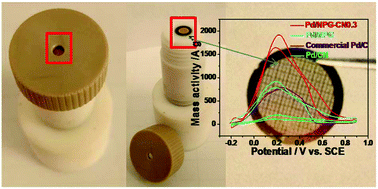Effective immobilization of nanoscale Pd on a carbon hybrid for enhanced electrocatalytic performances: stabilization mechanism investigations†
Abstract
The grand challenge inhibiting the use of electrocatalysts is the degradation of active species which results in poor durability and long-term performances. Studying the origin of active metal particle stabilization mechanisms by using supports and the immobilization-induced changes of active particles is of significant importance. This study describes the preparation of Pd nanoparticles supported by carbon hybrid NPG–CN, revealing that the mass and specific activities (1987 A g−1 Pd and 28.7 A m−2) of this catalyst for formic acid oxidation significantly exceed those of commercial Pd/C, and excellent stability and enhanced CO-poisoning tolerance properties are obtained. The origin of this behavior is probed by surface analytical techniques and identical-location transmission electron microscopy (IL-TEM), and the enhanced activity of Pd/NPG–CN is ascribed to the electronic effect of the substrate, the high content of surface metallic Pd0, and the reduced extent of active Pd leaching and physical ripening during the FOA process compared with commercial Pd/C. In addition, theoretical calculations demonstrate that NPG–CN can efficiently trap Pd atoms, which accumulate and form Pd clusters at trapping (nucleation) sites.



 Please wait while we load your content...
Please wait while we load your content...